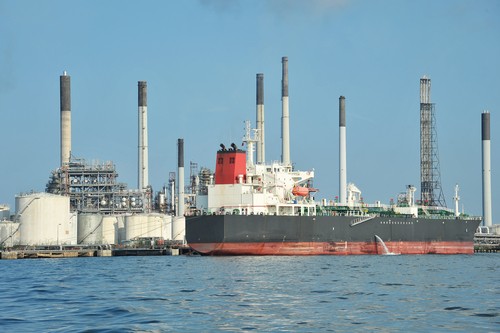(Bloomberg) — President Barack Obama and the governors of New York and New Jersey took steps to ease the misery of motorists waiting in miles-long lines for gasoline after Hurricane Sandy.
The Obama administration said today that it waived the Jones Act, which requires ships moving goods between U.S. ports to use U.S.-flag vessels. The action, which applies only to refined products, will increase the number of tankers available to transport fuel from Gulf Coast refineries to the East Coast.
The region also can expect delivery of 2 million gallons (7.6 million liters) of ultra-low-sulfur diesel from the Northeast home heating oil reserve to power emergency-response equipment. The fuel, from a depot in Connecticut, will be shipped as early as tomorrow, according to a statement from the U.S. Energy Department.
In New Jersey, Governor Chris Christie suspended restrictions on out-of-state fuel purchases, and said the state and the Federal Emergency Management Agency will deliver generators to filling stations shut by power outages. New York Governor Andrew Cuomo waived taxes and regulations to accommodate more fuel tankers and process them more quickly.
“People can’t get gas and it’s increased the stress level all throughout the region,” Cuomo, a 54-year-old Democrat, said today at a press briefing. “There should be a real change in the condition and people should see it quickly.”
One-Third
Tempers in New Jersey and New York have flared over days of power outages and difficulties buying gasoline for vehicles and portable electric generators. Utilities are under pressure from state officials and residents to restore service faster.
About 1.4 million customers in New Jersey, more than a third of homes and businesses, remain without electricity. About 300,000 had their service restored today, and the state was setting up temporary housing for 8,000 out-of-state utility workers, Christie told reporters in Brick, New Jersey.
Only 25 percent of gasoline stations north of Interstate 195, which runs from Mercer to Monmouth counties through the center of the state, are operating, Christie said.
“I’m concerned and frustrated too,” Christie said. “In the next 24 to 48 hours I think we’re going to start to see things getting better.”
Damage Prevention
Sandy’s winds and floods blacked out about two-thirds of New Jersey and crippled the region’s transit system. It also flooded fuel terminals, curbed deliveries and left many filling stations in the dark and unable to run pumps.
Cuomo said he expects most people in his state to have power back by late Nov. 4.
Gasoline supplies that have dwindled should be replenished after the U.S. Coast Guard reopened the Port of New York, Cuomo said.
Two million gallons of gasoline arrived in Newburgh, New York, last night, Cuomo said.
The fuel shortage resulted from ports being shuttered because officials feared shipping containers blown into the water by Sandy would damage passing ships, Cuomo said. Some sea lanes were reopened in New York’s harbor yesterday. Most of the terminals that were knocked out, including the one in Port Jefferson on Long Island, were back online with generators.
“We understand why there was a shortage, and the harbor is now open,” Cuomo said.
Gas Flow
Ships that travel between U.S. ports under the 1920 Jones Act are more expensive because they have to be built, owned and crewed in the country, said Urs Dur, a Clarkson Capital Markets analyst in New York. Allowing non-U.S. ships to carry fuel between American ports will temporarily help relieve a shortage of qualified vessels.
The Coast Guard is looking for other ways to speed up the flow of gasoline into the region, including allowing barges to directly pump fuel into trucks rather than first offloading into holding tanks, Rear Admiral Daniel Abel said at Cuomo’s press briefing.
“We’re turning the tide,” Abel said. “There’s no question the supply of fuel is going to increase in New York harbor.”
About 1.3 million customers in New York, or 14 percent of those in the state, were without power as of this morning, the Energy Department said.
Coney Island Avenue, a main artery in Brooklyn, was overwhelmed today with cars seeking gasoline. The line for a Hess station stretched almost a mile from Church Avenue to 18th Avenue. There was also a line of about 200 people waiting with gas cans — even though the station was out of fuel. People said they were waiting for a fresh delivery.
-By Elise Young and Freeman Klopott. Copyright 2012 Bloomberg.

 Join The Club
Join The Club











